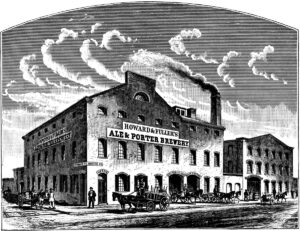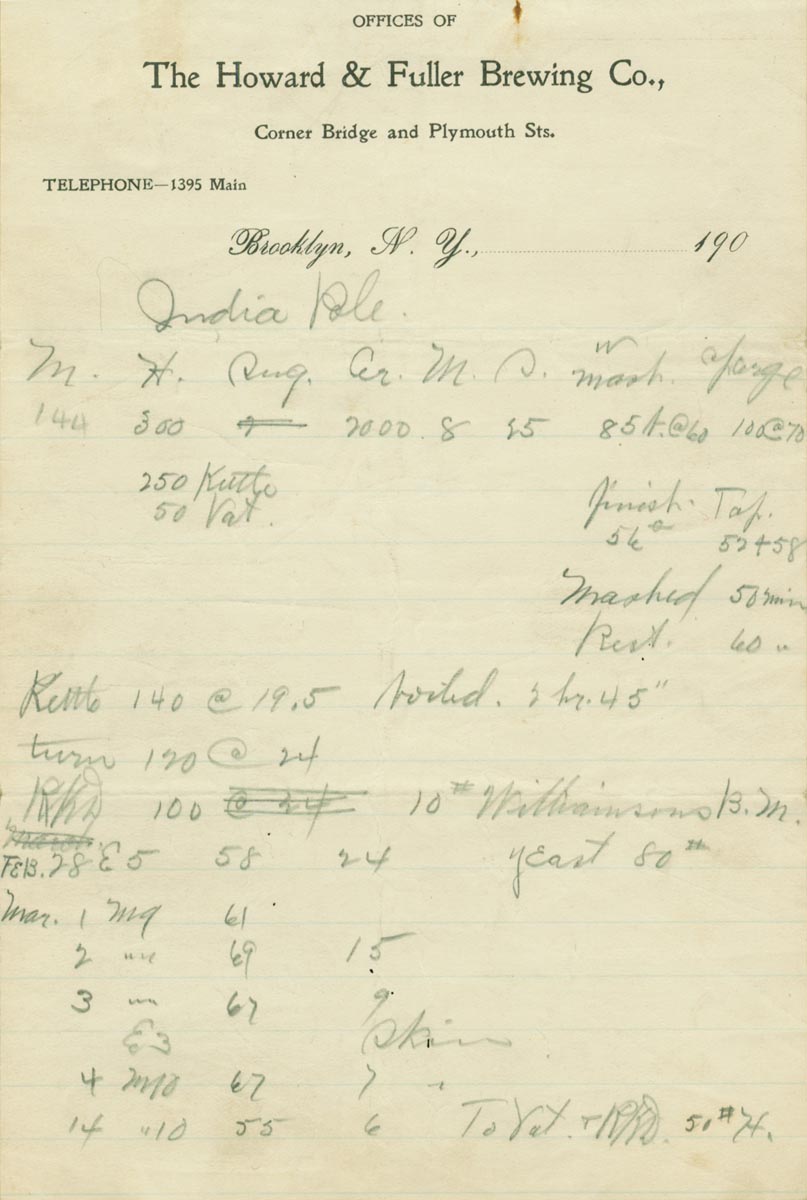©2004, Randy Mosher for All About Beer magazine
We think of India pale ales as representing the glory of the British Empire. And indeed, they served as global ambassadors of this nation at its zenith, shipping to the far flung corners of the earth. Everywhere they reached, they made an impression. This pale, clear, hoppy beer was a dramatic change from the darker and less hoppy beers generally popular in the eighteenth century. India pale ales were not just different, they were modern. Brewers in many places responded by brewing their own interpretations. In Pilsen, Bohemia, a new pale lager was created in 1842. Brewers in Belgium saw an opportunity to take advantage of the sizable trade in British ales there, and produced their own versions.
In America the lager revolution had largely displaced British-style ales by 1870 or so, but a soft spot remained for all things British. Porter and then pale ale were imported in huge volume up until the mid-to-late nineteenth century. Many breweries, especially in Eastern states, didn’t stop brewing ales when the lagers came in, but the ales did lean to brighter, crisper, cleaner flavors. India pale ale was part of the mix, usually at the very top end of a brewery’s range of products.
A session on eBay led to my acquiring a handwritten recipe from the Howard & Fuller Brewing Company of Brooklyn, NY. One Hundred Years of Brewing(1903) says: “This house manufactures fine ales and porters only and represents the oldest business in those lines on Long Island.” Founded by Junius A. Fuller in 1835, the brewery moved to the corner of Bridge and Plymouth Streets, a neighborhood now called DUMBO (Down Under the Manhattan Bridge Overpass), an up-and-coming area near the Brooklyn Bridge. The stationery is preprinted with the date 190_, so the recipe probably stems from that decade, but it could be a bit later. There’s a bit of shorthand in the brewer’s notes, so this may take a bit of guesswork to figure out.
Malt is listed as “144,” which could be bushels (34 lbs of malt), but based on the 24°Balling (1.100 OG) listed as the strength of the wort, must have been hundredweight, a measure of 112 lbs. This gives us 4.33 lbs per gallon. Since the malt is unspecified, I think we have to assume it’s domestic lager malt; whether it is two or six-row malt is an open question, but I’m going to recommend two-row, as it is much less likely to impart a husky taste as often happens with 100% six-row recipes.
The brewer lists a category for sugar, writes the number “2” then marks it out, which gives us permission to use a little sugar—an ounce per gallon—if we wish. It’s possible that the brewer was planning on using the sugar to adjust the gravity a bit, and then found he didn’t need it, so the beer was brewed with 100% malt. Ten pounds of “Williamson B.M” are listed as a late kettle addition. Williamson is a company that to this day manufactures caramel and other colorings for the food and beverage industry, so it seems likely that a small quantity of black malt was used to boost the color.
This was a hoppy beer, with 220 pounds of hops in the kettle and another 50 added when the beer was transferred to the aging vat. This corresponds to just over two pounds per barrel in the kettle, plus the dry-hopping. That’s six ounces in a 5-gallon batch—plenty bitter. At this time in the United States, hops were likely to have been the Cluster variety, sourced from New York or Wisconsin, as the Western hop fields were just getting started then. Cluster is a sturdy, stable, high-yielding hop with a decidedly second-rate flavor, and has mostly given way to more appetizing varieties. British and Continental hops were also sold by American hop dealers of the day, and these were often trumpeted on the labels of the premium beers in which they were used, so you have a little wiggle room.
By the notes, the mash appears to have been a straightforward infusion: 50 minutes of mashing (probably meaning stirring) and then an hour’s rest. Mash liquor (water) is given as “60” (degrees Reaumur), which would have been 167 °F; sparge temperature was 70°R, or 189.5 °F, all pretty reasonable. “Finish” mash temperature is listed at 56 °R, or 158 °F. A 2 hour, 45 minute boil is recorded. Wort gravity is recorded at “24” (°Balling) 1.100 original gravity, which would have made for a pretty beefy beer.
This beer would have been fermented and aged in Cyprus or oak vessels. The Wahl-Henius Handy Book (1908) recommends three to four months aging for stock ales of a slightly lower gravity, so I would think six months to a year would not be too long. Beers this strong and hoppy will improve in the bottle for five years or more if well cared for. Analyses in the same book show lactic acid levels about double those of lager, between 0.25 % and 0.4%, about the same range as British versions (by comparison, lambics of the day were about 1% lactic acid). The use of oak in your version is optional, but if you do go that route, quantities should be very small.

DUMBO IPA (5 Gallons/19 liters)
OG: 1.100 (24°P); 96 IBU; 7–8.5 % alcohol/vol
20 lb (kg) US 2-row lager malt
0.2 oz (6g) black patent malt, added at end of boil
Mash one hour at 155 °F (66 °C), then mash-out by adding sparge water to raise the mash temperature to 170 °F (77 °C).
For an extract recipe, substitute lb (kg) of pale dried malt extract for the malt.
Hops:
3 oz (g) 165 min Cluster (6 %AA)
2 oz (g) 165 min US Goldings (4.5 %AA)
1 oz (28g) dry hop East Kent Goldings (5 %AA)
Yeast should be the old Ballantine’s strain: Wyeast 1056 or White Labs WLP 001, although there’s no reason why other English-derived yeast wouldn’t work.

